#fashion bog
Text
Time Travel Question 35: Ancient History XVI and Earlier
These Questions are the result of suggestions from the previous iteration.
This category may include suggestions made too late to fall into the correct earlier time grouping. Basically, I'd already moved on to human history, but I'd periodically get a pre-homin suggestion, hence the occasional random item waaay out of it's time period, rather than reopen the category.
In some cases a culture lasted a really long time and I grouped them by whether it was likely the later or earlier grouping made the most sense with the information I had. (Invention ofs tend to fall in an earlier grouping if it's still open. Ones that imply height of or just before something tend to get grouped later, but not always. Sometimes I'll split two different things from the same culture into different polls because they involve separate research goals or the like).
Please add new suggestions below if you have them for future consideration. All cultures and time periods welcome.
#Time Travel#Cybele#Ancient World#Trans History#Vesuvius#Pompeii#Roman Empire#Bog Mummies#Fashion History#Tyrian Purple#Bronze Age#Iron Age#Indigenous History#Egyptian Blue#Mediterranean#Mediterranean Sea#African History#Western Asian History#European History#Queer History#Epidaurus
245 notes
·
View notes
Text
Photos of 16th-17th century Irish clothing
Extant garments in the National Museum of Ireland
Notes: The garments in this post are all bog finds which means their current color may not be their original color. Although some of these items were found with human remains, no photos of human remains are included in this post.
Killery Cóta Mór (great coat) and brogues:
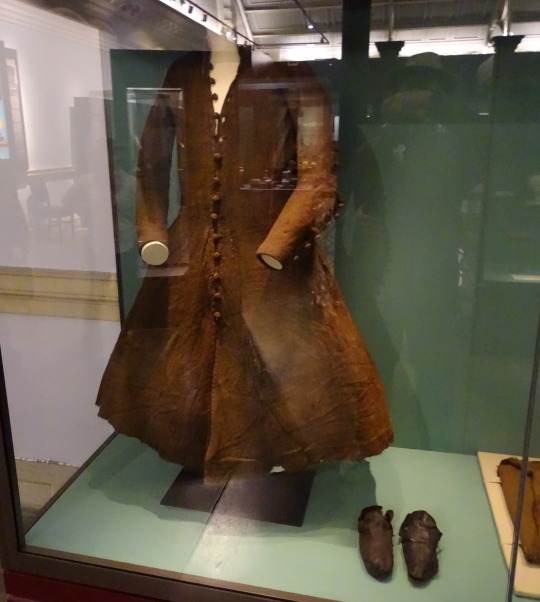
photos by hayling billy used under non-commercial, share alike license
The Killery outfit comes from an adult male bog body found in Killerry parish, Co. Sligo in 1824. It includes a cóta mór, triús, a brat, and shoes which are on display in the museum, and a sheepskin biorraid (conical hat) which fell apart shortly after it was found (Briggs and Turner 1986).
Killery triús (trews):
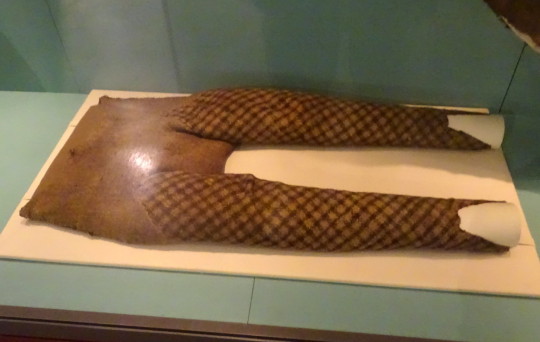
photo by hayling billy
Killery outfit with and without brat:

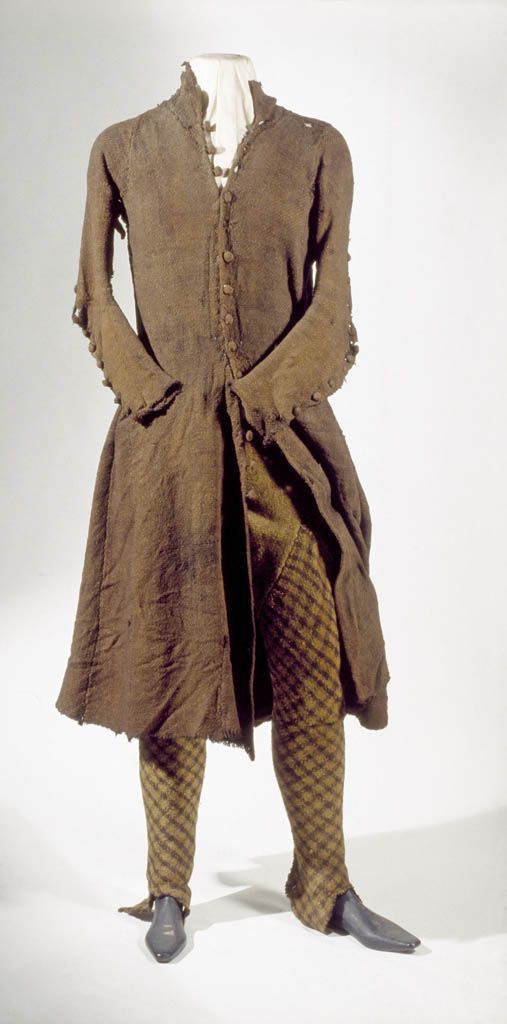
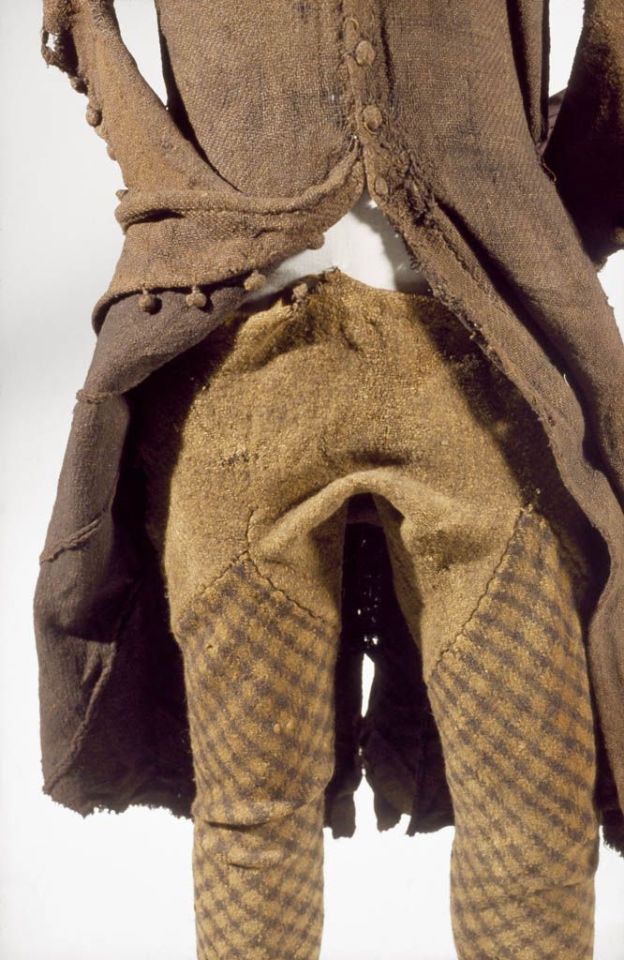
The outfit is generally dated to the 17th c. (Dunlevy 1989). It matches Luke Gernon's 1620 description of Irish men's winter apparel:
"in winter he weares a frise cote. The trowse is along stocke of frise, close to his thighes, and drawne on almost to his waste, but very scant, and the pryde of it is, to weare it so in suspence, that the beholder may still suspecte it to be falling from his arse. It is cutt with a pouche before, which is drawne together with a string."
Additional photos of the outfit: cóta front, hem, buttons, and brat.
Shinrone gown:
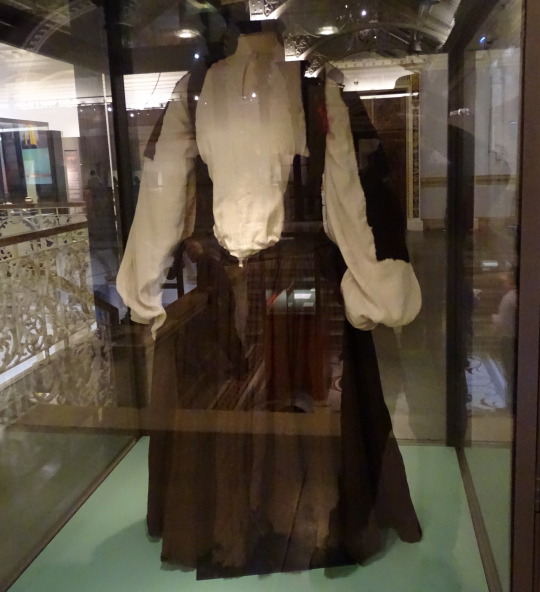
photo by hayling billy
The Shinrone gown was found in a bog in 1843 in Co. Tipperary near Shinrone, Co. Offaly. Unlike the Killery outfit, there were no human remains or other items found with it (Briggs and Turner 1986). The ends of the sleeves and possibly also the bottom of the skirt are missing. The sleeves would have had wrist cuffs or ties that allowed them to be fastened around the wearer's wrists. It probably also had loops or rings along the U-shaped center-front opening for lacing. It is typically dated late 16th-early 17th c, based on its similarity to a circa 1575 illustration by Lucas DeHeere and to the dresses described by Luke Gernon in 1620 (Dunlevy 1989, McGann 2000). It could be older however, because Laurent Vital described dresses with this type of sleeve in 1518.
Copyrighted, better quality photos: left front, right front, back Additional details: side-front, front waistline
Tipperary Cóta Mór:
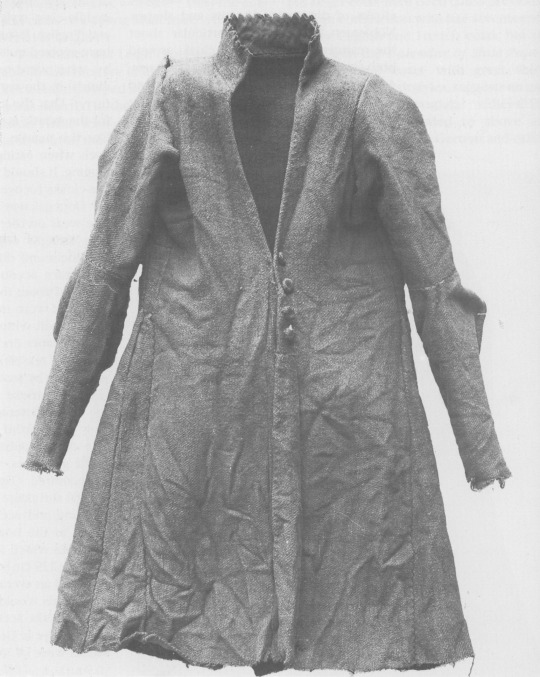

photos from Dunlevy 1989 and hayling billy
Another Cóta Mór. This one is from Co. Tipperary, exact find spot and date unknown. Like the Shinrone gown, it was not found with human remains or other items (Ó Floinn 1995). It is probably also from the 17th century (Dunlevy 1989).
Additional photos: front, side, front buttons, front detail, side
Brat and hats:

photo by hayling billy
I haven't been able to find any clear photos of the label on this display, but based on the excellent condition and the presence of the leather tie, I think this is the Meenybradden woman's brat.
Closeup of the tie:
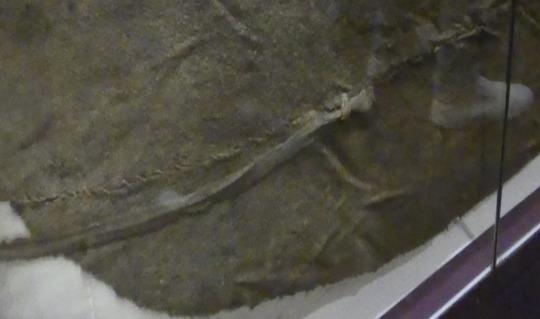
The Meenybradden woman is a bog body found in Meenybradden bog, Co. Donegal in 1978. The brat was wrapped around her as a shroud and secured with the leather tie (Delaney and Ó Floinn 1995). No other garments or artifacts were found with her, although she may have been wearing a linen garment such as a léine when she was buried. Linen tends to not survive in bogs. The Meenybradden woman has a calibrated radiocarbon date of AD 1130-1310, but some archaeologist have suggested humic contamination from the peat may be throwing off the dating. Her brat is identical in cut to others from the 16th-17th centuries (Delaney and Ó Floinn 1995).

Meenybradden brat laid flat. (photo from Delaney and Ó Floinn 1995)
Wool hats:

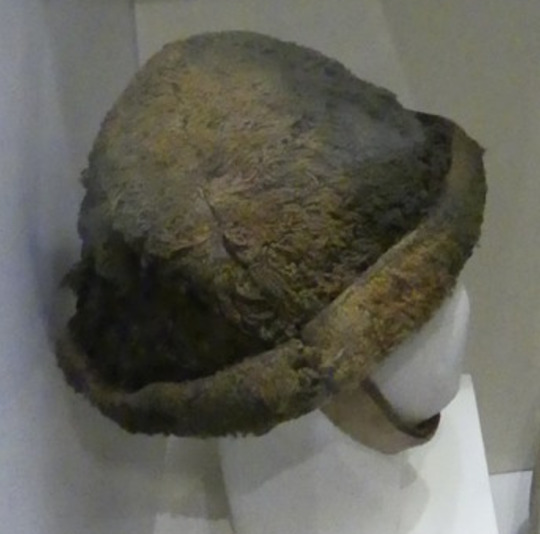
Hats from Boolabaun, Co. Tipperary made of wool felt which has been cut and sewn to form the shape. They have togs of unspun wool worked into them giving them the appearance of faux fur. Dunlevy suggests a 15th-16th c date for them (Dunlevy 1989, McClintock 1943).
Wool cloak:
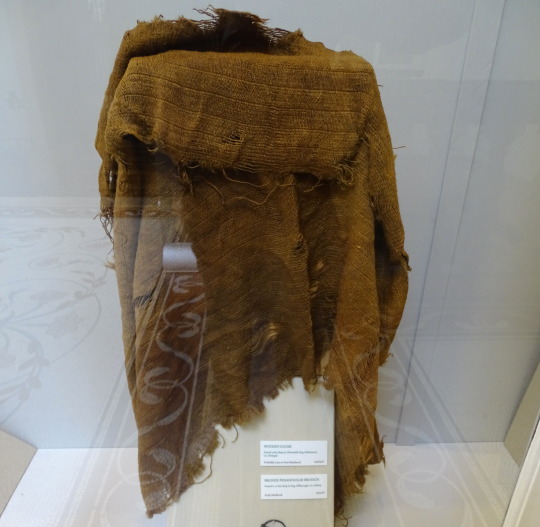
photo by hayling billy
The museum label says it's from Glenmalin bog, Malinmore, Co. Donegal, but I think this may be a mistake. According to Ó Floinn (1995), the artifact with accession number 1946:416 from Malinmore, Co. Donegal is a bale of linen. Ó Floinn's table also gives accession number 1946:416* for a group of clothing from Owenduff, Co. Mayo which includes a gown, a jacket, and a cloak. If the cloak in the photo is actually the one from Owenduff, it is probably from the 17th c (Dunlevy 1989). Alternatively, someone might have misidentified a wool cloak as a bale of linen. The museum label dates this as late Medieval to post-Medieval.
*Either Ó Floinn made a typo or this is a mistake in the museum records. Museums are not supposed to give the same accession number to 2 different artifacts. In the NMI's defense, 1946 was probably a messy year for everyone.
Bibliography:
Briggs, C. S. and Turner, R. C. (1986). Appendix: a gazetteer of bog burials from Britain and Ireland. In I. Stead, J. B. Bourke and D. Brothwell (eds) Lindow Man: the Body in the Bog (p. 181–95). British Museum Publications Ltd.
Delaney, M. and Ó Floinn, R. (1995). A Bog Body from Meenybradden Bog, County Donegal, Ireland. In R. C. Turner and R. G. Scaife (eds) Bog Bodies: New Discoveries and New Perspectives (p. 123–32). British Museum Press.
Dunlevy, Mairead (1989). Dress in Ireland. B. T. Batsford LTD, London.
Gernon, Luke (1620). A Discourse of Ireland. https://celt.ucc.ie/published/E620001/
McClintock, H. F. (1943). Old Irish and Highland Dress. Dundalgan Press, Dundalk.
McGann, K. (2000). What the Irish Wore/The Shinrone Gown — An Irish Dress from the Elizabethan Age. Reconstructing History. http://web.archive.org/web/20080217032749/http:/www.reconstructinghistory.com/irish/shinrone.html
O’Floinn, R. (1995). Recent research into Irish bog bodies. In R. C. Turner and R. G. Scaife (eds) Bog Bodies: New Discoveries and New Perspectives (p. 137–45). British Museum Press.
Vital, Laurent (1518). Archduke Ferdinand's visit to Kinsale in Ireland, an extract from Le Premier Voyage de Charles-Quint en Espagne, de 1517 à 1518. translated by Dorothy Convery and edited by me. https://irish-dress-history.tumblr.com/post/721163132699131904/laurent-vitals-1518-description-of-ireland
#16th century#17th century#irish dress#dress history#gaelic ireland#historical men's fashion#historical women's fashion#bog finds#irish history#historical dress#brog#bratanna#irish mantle#headwear#triús#cóta mór
71 notes
·
View notes
Text

May I present, a 4th boggy solo rpg game! (Check out my other three here)
In Johnny Bogg: a boggy shopping trip adventure, you play as a fat person going to buy some plus sized masculine clothes. Luckily for you, a new branch of your fav plus sized masc clothing store has opened up near you! It might be in a bog, but you won't let that stop you!
In Johnny Bogg, you'll play to figure out what weird boggy things happen to you while shopping. Complete with a customer survey!
Play Johnny Bogg: a boggy shopping trip adventure here, for pay what you want!
#solo rpg#solo journaling game#solo journaling rpg#indie ttrpg#indie rpg#wetlands#bogs#plus sized fashion#my ttrpgs
31 notes
·
View notes
Text

oh so we’re doing this again are we?
#first time since that stupid fast fashion post blew up that i’ve gotten over a thousand notifs just overnight#what are you even doing on my blog?? i feel like there are people in my bog#*shakes cane at you all* get off my blog you whippersnappers!!
39 notes
·
View notes
Text

Selfship Ref Sheet #3: Tate Langdon (#my ghost boy)
Is it problematic if you were born in the same year but one of you died at seventeen?
Either way, we're going to adopt an entire household of ghost kids together!! Honestly this is 80% a platonic selfship with the other members of the house but the other 20% is making Tate feel overwhelmingly loved and appreciated.
#i've been working on my season 1 rewrite with my s/i and it's fun#i keep getting bogged down in the witchcraft stuff#i'm trying not to write a ritual manual lol i just wanna get back to the characters#but my heart wants to write the evocation of all four directions T-T#anyways#my selfships#selfship art#my ghost boy#added the purple streak to this s/i's design as a nod to my 2000s fashion#ref sheets
13 notes
·
View notes
Text
after a couple years of getting used to his bestie living on cardassia married to a cardassian with cardassian babies miles finally visits julian instead of the other way around and takes the whole family (keiko always wanted to get an in-person cardassian botany experience even after the Fire destroyed most of the local vegetation!) and the kids just LOVE him. will NOT leave him alone. young elim insists on imitating his accent which everyone but miles thinks is hilarious
#dee s 9#garashir adoption au#the girls are obsessed with any female presenting alien. especially older women with an elegant fashion sense#molly wants to clomp around the acid bogs and look at bugs and nobody wants to join her u_u#young elim following miles around muttering “damn it julian” under his breath in a thick fake irish brogue#idan: dabbit juban#garak miles VERY cold war truce over the breakfast table#julian and miles taking the communal skimmer out to the badlands to skeetshoot with decommed phasers#and eat biscuits and red leaf tea that young elim prepared for them (in a very cute basket)
51 notes
·
View notes
Text


#black women#fashion#swampcore#cottagecore#bones#alt black girl#alternative#afropunk#witchycore#toadpunk#bog vibes#witchy
9 notes
·
View notes
Text
Cosy Witch OOTD


Going for a kinda ✨ autumn moon witch ✨ vibes. Or like, Eda the owl lady but instead it's Ghoul the crow lady 😌🔮
#fashion#ootd#outfit inspo#style inspiration#witchcore#bog witch#owl house#eda clawthorne#crow lady#owl lady#cryptid#cryptidcore#fall aesthetic#autumn aesthetic#crowcore#moon belt#natural makeup#goth outfit#plus size goth#mothcore#cozycore#cozy outfit#cosycore#warm and comfy
43 notes
·
View notes
Text

a teenage girl told me yesterday i look cool 🥰
29 notes
·
View notes
Photo

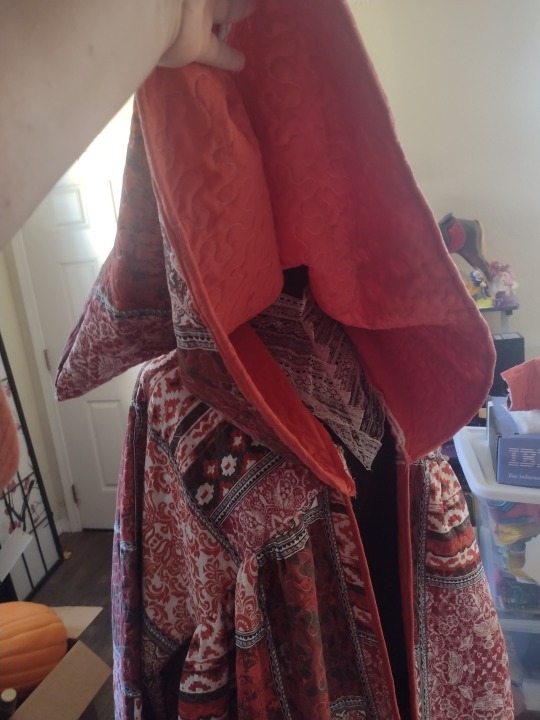

Wizardly quilted bog coat with hood! 8D Because the blanket was so big(king size) I was able to make the hood and pocket with offcuts from the sleeves and top edge, and I still have plenty for adding more pockets later(which I will). Haven’t finished the internal seams yet but that’s okay i can do that later.
Since I used offcuts for the hood and pocket, I was able to use the pillow shams to make an entirely-too-large messenger bag(which i haven’t photographed yet), with a folded strip of blanket for the strap. It will carry my enormous laptop, my laptop accessories including my lap desk thingie, and probably a good bit more comfortably. I, however, will have to try to not fill it up to capacity so that /I/ can carry /it/.
32 notes
·
View notes
Text
Drawn after the Quick
(ie Drawn from Life)

Colored woodcut print by an unknown English artist, generally dated to 1540-1550, possibly depicting Irish kerns who fought for King Henry VIII at the siege of Boulogne in 1544.
All 6 of the men wear a léine (linen tunic) with an ionar (short jacket) over it, and the 4 on the left have a brat (wool mantle). The men have their léinte rucked up to knee length and secured at the waist with a belt or cord. The léinte have the wide hanging sleeves that are typical of 16th c. Gaelic fashion. They also have a deep center-front opening, a feature which matches Burgundian courtier Laurent Vital's description of clothing he saw during his 1518 visit to Kinsale, Co. Cork:
"Generally the men, women, and young girls wear their shirts open to the waist. Most young women and girls have their chests naked to the waist." (translation taken from a lecture by Katherine Bond)
The ionair in this print are very similar in cut to the ionar of the Kilcommon bog outfit. The hat worn by the man in the red ionar is also similar to the hat of the Kilcommon outfit.
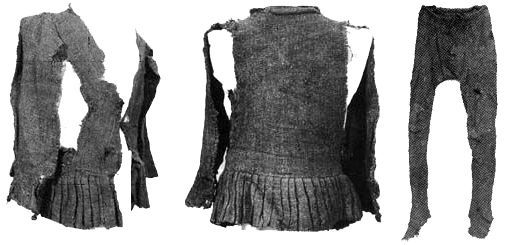

The floral scroll design seen on some of the ionair was a popular embroidery motif in England during the 16th-early 17th centuries. It also shows up in 16th c. Irish art like St. Brigid's shoe shrine.

4 of the ionair and all of the visible scabbards have fringe on them. Fringe was a popular embellishment in 16th c. Ireland. The use of fringe is mentioned in several 16th and early 17th c. descriptions of Irish clothing. Fringes made of wool and fringes made of silk were imported into Ireland during the 16th c.
In spite the claim that it was drawn from life, this print includes some stylistic exaggeration. The sword blades are depicted as having a bulbous tip, which actual Irish ring-pommel swords are not. Compare the swords in the print to this extant 16th c. sword from Tully Lough, Co. Roscommon in the NMI:

The print is currently in the collection of the Ashmolean Museum. https://collections.ashmolean.org/object/737327
Bibliography:
Arnold, Janet, Tiramani, J., & Levey, S. (2008). Patterns of Fashion 4. Macmillan, London.
Dunlevy, Mairead (1989). Dress in Ireland. B. T. Batsford LTD, London.
Flavin, Susan (2011). Consumption and Material Culture in Sixteenth-Century Ireland. PhD thesis.
McClintock, H. F. (1943). Old Irish and Highland Dress. Dundalgan Press, Dundalk.
Irish Ring Pommel Sword: New Insight into Use
National Museum of Ireland talk on St. Brigid's shoe shrine
Depicting and Describing Dress in Early Modern Ireland: lecture by Dr. Katherine Bond
#irish dress#gaelic ireland#irish history#irish mantle#bratanna#leine#ionar#fringe#embellishment#historical men's fashion#headwear#art#16th century#anecdotes and observations#dress history#bog finds#extant garments
22 notes
·
View notes
Text

#me#horns#witchy#witch of the woods#bog witch#vibes#alternative fashion#technically just an honorary witch
2 notes
·
View notes
Text
So now that I'm almost free from research into 19th and 20th century fashion (which I really enjoyed, don't get me wrong), I can finally start learning things for the heck of it again which meansssss yes hello (early) 18th century fashion for definitely non pirate related reasons
#i just love all the bright colours and flower patterns#also. pirates. yknow.#but also genuinely I want to learn more about pre-1800s fashion in general#bog bodies! super old history! medieval times! 80 years war! 18th century!#whatever peasants were up to any given moment!
3 notes
·
View notes
Text

I just need to descend into madness a liiittle further and I’ll start dressing like this.
19 notes
·
View notes

